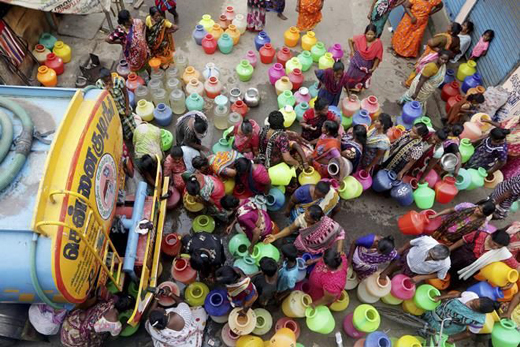
Water crisis: Nine steps to address the shortage
Mangalore Today News Network
July 16, 2019: Only 4% of world’s water resources are available to us, and we have to provide for 16% of world’s population. Thus, our huge water shortage is sure to land us in a critical situation, if urgent steps are not taken. We are already seeing water shortage in Tamil Nadu, Rajasthan, Uttar Pradesh, Telangana and Haryana.

In his Mann Ki Baat 2.0, PM Narendra Modi—the first after his re-election—pitched for water conservation to be made into a mass movement in India, amid reports of depleting water resources due to several reasons. In India, agriculture consumes nearly 80% (65% in China) of fresh water and the rest 20% is used for drinking and other household activities. Thus, and rightly so, the government launched the Jal Shakti Abhiyan (JSA) on July 1.
The objective of JSA is to take measures for rainwater harvesting, water conservation and replenishing water bodies for meeting acute shortage of water. Today, India conserves only 8% of the rainfall it receives, which is among the lowest in the world, and we need to change this. Further, only 4% of world’s water resources are available to us, and we have to provide for 16% of world’s population. Thus, our huge water shortage is sure to land us in a critical situation, if urgent steps are not taken. We are already seeing water shortage in Tamil Nadu, Rajasthan, Uttar Pradesh, Telangana and Haryana. NITI Aayog’s report of 2018 asserts that that groundwater in 21 cities of India is set to plunge to bare minimum levels by 2020. Is it not alarming?
Although water crisis in now a worldwide phenomenon (two-thirds of the global population is living under water-stressed conditions and, by 2025, about 1.8 billion people are expected to face absolute water scarcity), but it is much worse in India due to mismanagement of water usage in agricultural operations. The latest available World Bank statistics show that while India produced $0.5 of agricultural GDP (in 2010) for a litre of fresh water, this figure is $1.6 for China (in 2012) and $3.9 for Israel (in 2004)—a success story in efficient use of water for agriculture. In fact, there has been no increase in agricultural output per unit of water usage in our country during the last three decades. In view of this grim scenario, the following measures are suggested:
1 Recycle sewage and other household waste water by setting up water-treatment plants, using innovative technologies, and reuse the extracted water for irrigation. Singapore, Windhoek (capital of Namibia) and Israel are great examples of treating such water for reuse and even for drinking.
2 Increase awareness among the masses about scarcity of water and the dire need of conserving it by organising programmes/public meetings on efficient use of water.
3 Impose suitable penalties for wasting and polluting water, and also limit per capita use of water and impose fines for exceeding the limit. Perhaps there would be no need for doing so once people are made aware of the problem.
4 Traditional water conservation/harvesting methods like constructing farm ponds, check dams, gully plugging, dug wells, borewells and artificial glaciers in Ladakh; Tamaswada Pattern nallahs treatment in Maharashtra; soak pits in Punjab; and watershed development and management in Maharashtra and Madhya Pradesh—which have become defunct in some parts—must be revived.
5 Agricultural universities should take a lead in advising farmers on suitable cropping patterns, taking into account soil and other climatic conditions of a region, to save water.
6 Promote use of drip irrigation and sprinklers.
7 In urban areas, there is water theft and also loss of clean water due to slackness on the part of water management bodies. This is due to inferior water service infrastructure and its poor maintenance. This needs to be corrected by adopting strict procedures for compliance and monitoring.
8 Though it may be an unpopular measure in the existing political environment, the practice of providing free or subsidised water and power to farmers must be stopped. This would not matter much for big farmers as they are not liable to pay income tax as others do. Of course, small and marginal farmers may need to be compensated for this loss by increasing the MSP for their produce. Here it must be mentioned that free power to farmers not only leads to excessive withdrawal of groundwater, but also increases soil salinity, which jeopardises farm sustainability.
9 It is learnt that, while launching JSA, the government announced reorientation of MGNREGA towards water conservation and harvesting by reserving 75% (instead of 67% in 2018-19) of 2.58 billion person-days expected to be generated during 2019-20. To walk the talk, it would be necessary to provide adequate funds to complete all pending water storage projects in states.
To sum up, although water crisis in urban areas normally attracts governments’ attention, it is the inefficient agricultural sector that is largely contributing to this situation in India. We hope the Centre and states will pay heed to these steps, else JSA would not be able to achieve its objective.
Remember, unlike oil, water has no substitute.
Courtesy:financialexpress.com